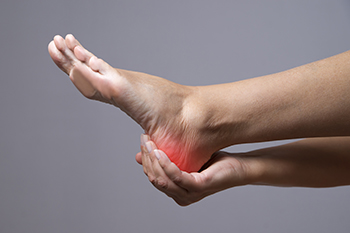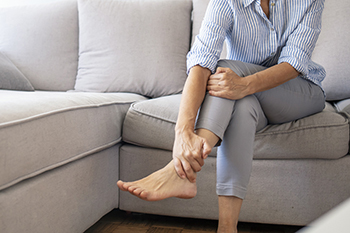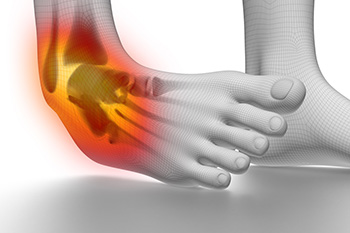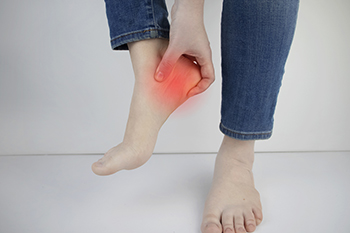
Heel pain is generally considered an overuse injury, most commonly caused by plantar fasciitis, Achilles tendonitis, or arthritis. Other causes include heel bursitis, stress fractures, and tarsal tunnel syndrome. Plantar fasciitis, the most common form of heel pain, is frequently caused by wearing shoes that lack support or proper cushioning while running or jumping on hard surfaces. Other causes include flat feet, high arches, aging, and being overweight. These conditions can cause the plantar fascia, a band of tissue that connects the toes to the heel, to get overstretched and become inflamed. Achilles tendonitis is the inflammation of the Achilles tendon, which connects the leg bones to the heel. Bursitis is an inflammation of the bursa, sacs of fluid behind the heel. Stress fractures can be caused by heavy pounding on the heel, during certain sports activities or running. Tarsal tunnel syndrome is caused by a pinched nerve. Aging can cause the fat pads in the heel to thin out, resulting in less natural cushioning. Obesity places extra pressure on the heel, even during normal daily activities. Please consult a chiropodist for help with any heel pain you may be experiencing.
Heel pain is a common problem that can be caused by a variety of injuries, medical conditions, and other factors. If you suffer from heel pain, please consult with one of the chiropodists from The Footcare Centre. Our chiropodists can help you maintain the health of your lower limbs and your mobility.
When it comes to heel pain, the exact location and type of pain are important to note. Some of the conditions that may cause heel pain include:
Plantar fasciitis - An inflammation of the ligament that runs along the bottom of the foot; it causes a stabbing pain under the heel that is at its worst when taking your first few steps after a long rest and while standing on your tiptoes or climbing stairs
Achilles tendonitis - An inflammation of the tendon in the back of the calf; it causes pain in the back of the heel that is at its worst after resting, as well as ankle and calf stiffness, swelling, and tenderness
Bone spurs - Bony lumps on the back of the heel bones that cause sharp pain upon first standing up; the pain becomes dull and achy over time
Heel fractures - A break or crack in the heel bone that causes pain, swelling, and difficulty walking
Retrocalcaneal bursitis - Swelling of the small, fluid-filled sac at the back of the heel bone; it causes pain, swelling, redness, and warmth in the back of the heel
Tarsal tunnel syndrome - Compression of the posterior tibial nerve which causes a pins and needles sensation in the heel, foot, and calf
Your chiropodist will be able to diagnose the underlying cause of your pain and prescribe the right treatments for you. If you have any questions, please feel free to contact our office located in . We offer the newest diagnostic and treatment technologies for all your foot care needs.






